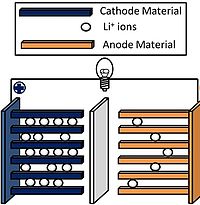
Photo from wikipedia
Abstract Sr2FeMoO6-δ double perovskites are widely-recognized due to several important factors: high electronic conductivity and electrocatalytic activity, structural stability under reducing atmospheres, high transition temperature, enormous magnetoresistance, reasonable tolerance to… Click to show full abstract
Abstract Sr2FeMoO6-δ double perovskites are widely-recognized due to several important factors: high electronic conductivity and electrocatalytic activity, structural stability under reducing atmospheres, high transition temperature, enormous magnetoresistance, reasonable tolerance to carbon formation, and their desirable capacity to avoid sulfur poisoning. One of the methods most commonly-used to synthetize these perovskites is solid-state reaction. The precursor phases usually associated with this method are the oxides SrMoO4 and SrFeO3-δ when Fe2O3, SrCO3, and MoO3 are the initial reagents used. Morphological, XRD (Rietveld), and thermogravimetry (calcination and reduction) analyses are steps or routes towards achieving the final result. While recent studies suggest that the temperature of calcination is always 900 °C and that reduction occurs at 1200 °C, they fail to explain why this occurs. This article demonstrates, according to the results of thermogravimetric analysis (TGA), that as calcination advances weight loss increases until a temperature of 850 °C is reached. In addition, it stresses the importance of the ball milling technique at ambient temperature to prevent sublimation of the MoO3 compound at 700 °C in the later steps of synthesis, such as calcination and reduction. According to the kinetic study, the values of activation energy (Ea) and reaction order (n) were 130.47 kJ/mol and 1 respectively.
Journal Title: International Journal of Hydrogen Energy
Year Published: 2021
Link to full text (if available)
Share on Social Media: Sign Up to like & get
recommendations!